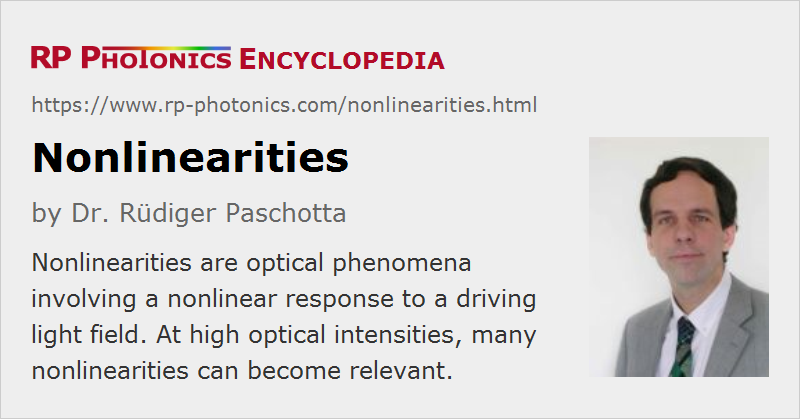Nonlinearities
Definition: optical phenomena involving a nonlinear response to a driving light field
More specific term: parametric nonlinearities
German: Nichtlinearitäten
Categories: fiber optics and waveguides, nonlinear optics
How to cite the article; suggest additional literature
Author: Dr. Rüdiger Paschotta
Lasers can be used for the generation of light with very high optical intensities. These can give rise to a number of nonlinear optical effects (→ nonlinear optics), the most important of which are:
- Parametric nonlinearities occur in certain crystal materials with χ(2) nonlinearity, giving rise to effects such as frequency doubling, sum and difference frequency generation, and parametric amplification (→ nonlinear frequency conversion).
- There are also parametric nonlinearities arising from χ(3). The Kerr effect raises the refractive index by an amount which is proportional to the intensity. This is related to effects like self-focusing, self-phase modulation, cross-phase modulation, and four-wave mixing.
- Spontaneous and stimulated Raman scattering is the interaction of light with “optical phonons”.
- Spontaneous and stimulated Brillouin scattering is the interaction of light with “acoustic phonons” and typically involves counterpropagating waves. Brillouin and Raman scattering are related to the non-instantaneous part of the third-order nonlinear response.
- Two-photon absorption is a process where two photons are simultaneously absorbed, leading to an excitation for which a single photon energy would not be sufficient. Its strength is related to the imaginary part of the χ(3) tensor, and is generally large for semiconductor media with small band gap energy.
There are also various other effects which are not directly based on optical nonlinearities, but are nevertheless affecting optical phenomena:
- Saturation of gain occurs particularly in lasers and amplifiers. Similarly, there are nonlinear losses in saturable absorbers, e.g. in SESAMs used for passive mode locking or Q switching.
- Photorefractive effects are observed in certain ferroelectric crystals such as LiNbO3. They are used for, e.g., holographic data storage, and can be detrimental in nonlinear frequency conversion.
- There are various kinds of effects involving heating, e.g. thermal lensing in laser gain media or thermal detuning of optical resonators (e.g. enhancement cavities).
In optical fiber technology, optical nonlinearities are of high interest. In fibers there is a particularly long interaction length combined with the high intensity resulting from a small mode area. Therefore, nonlinearities can have strong effects in fibers. Particularly the effects related to the χ(3) nonlinearity – Kerr effect, Raman scattering, Brillouin scattering – are often important, despite the relatively weak intrinsic nonlinear coefficient of silica: either they act as essential nonlinearities for achieving certain functions (e.g. pulse compression), or they constitute limiting effects in high-power fiber lasers and amplifiers.
Usually, the strength of nonlinear effects is determined by the peak power. However, there are cases where stronger effects occur for lower peak powers, as explained in a Spotlight article.
Strong nonlinearities also occur at intensities which are high enough to cause ionization in the medium. This can lead to optical breakdown, possibly even associated with laser-induced damage of the material. In gases, extremely high optical intensities can be applied, which can lead e.g. to high harmonic generation.
Questions and Comments from Users
Here you can submit questions and comments. As far as they get accepted by the author, they will appear above this paragraph together with the author’s answer. The author will decide on acceptance based on certain criteria. Essentially, the issue must be of sufficiently broad interest.
Please do not enter personal data here; we would otherwise delete it soon. (See also our privacy declaration.) If you wish to receive personal feedback or consultancy from the author, please contact him e.g. via e-mail.
By submitting the information, you give your consent to the potential publication of your inputs on our website according to our rules. (If you later retract your consent, we will delete those inputs.) As your inputs are first reviewed by the author, they may be published with some delay.
Bibliography
| [1] | G. P. Agrawal, Nonlinear Fiber Optics, 4th edn., Academic Press, New York (2007) |
| [2] | R. Paschotta, tutorial on "Passive Fiber Optics", Part 11: Nonlinearities of Fibers |
See also: nonlinear optics, effective nonlinear coefficient, laser-induced breakdown, nonlinear crystal materials, nonlinear frequency conversion, nonlinear polarization, nonlinear index, saturable absorbers, fibers, The Photonics Spotlight 2007-09-01
and other articles in the categories fiber optics and waveguides, nonlinear optics
 |




If you like this page, please share the link with your friends and colleagues, e.g. via social media:
These sharing buttons are implemented in a privacy-friendly way!